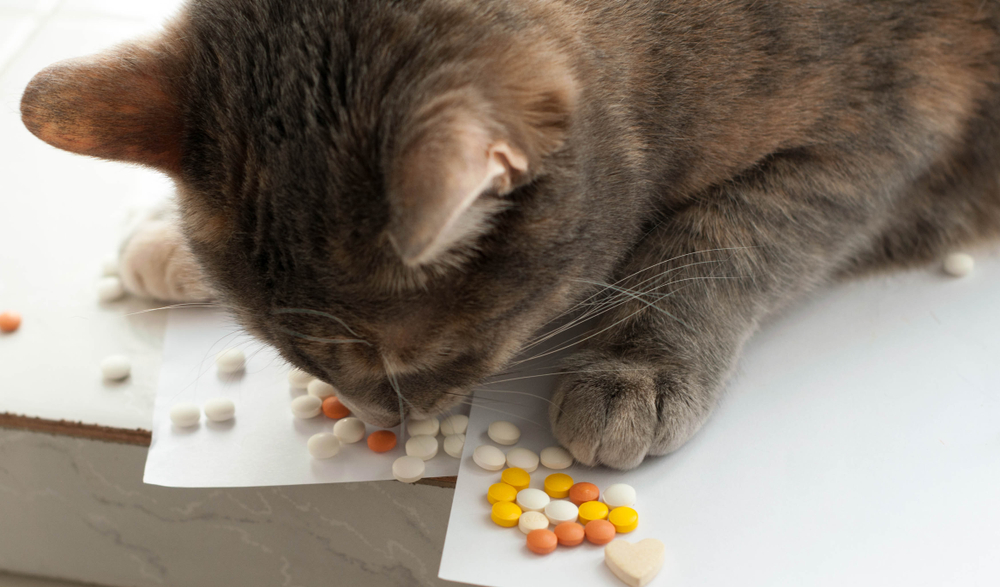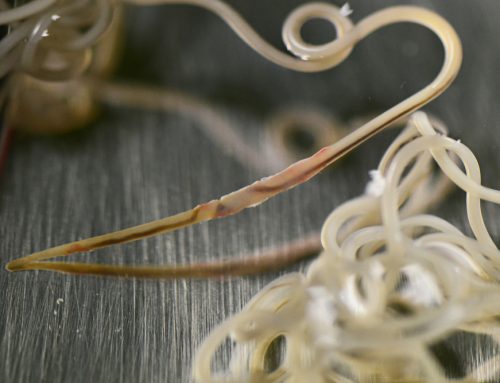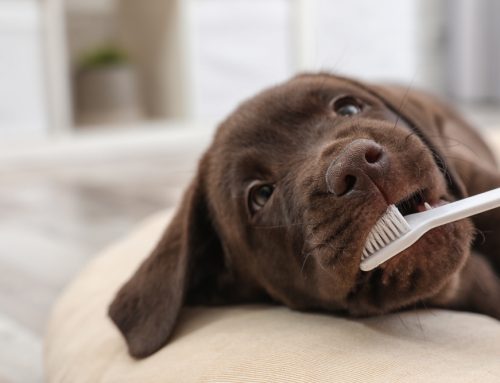Nothing can make you feel worse than witnessing your pet ingest something they shouldn’t, and panicking as you try to determine if the substance is toxic. To prevent your pet from being poisoned, the more you know about household toxins, the better. In honor of Pet Poison Prevention Month, our Pierson Pet Hospital team is sharing a list of the most common pet toxins, so you can help prevent your pet from ingesting a household poison.
Pet Toxin #1: Human medications
When pet-proofing your home, start with your medicine cabinet. Nearly 50% of all calls Pet Poison Helpline receives involve human medications—both over-the-counter (OTC) and prescription drugs. While pets can safely take some drugs intended for people, their dosages are much smaller. As little as one prescription or OTC pill can result in a massive overdose. Contact your veterinarian immediately if your pet has or may have ingested a medication from these groups:
- Nonsteroidal anti-inflammatory drugs (NSAIDs) — NSAIDs, such as ibuprofen, are common pain relievers and fever reducers. If your pet ingests an NSAID, they can develop gastrointestinal (GI) ulceration and kidney damage. NSAID ingestion signs include vomiting, dark, tarry stools, inappetence, lethargy, and coma.
- Acetaminophen — Acetaminophen (e.g., Tylenol) is a popular pain reliever for people that can harm your pet. Acetaminophen damages cats’ and dogs’ red blood cells, impairing their ability to carry oxygen throughout your pet’s body. Dogs who ingest acetaminophen can also experience liver damage.
- Antidepressants — Some antidepressant drugs are prescribed at veterinary doses for cats and dogs with anxieties or phobias. However, because each species requires a significantly different dosage, you should never give your pet your antidepressant medication without a veterinary prescription.
- Attention deficit hyperactivity disorder (ADHD) and attention deficit disorder (ADD) medications — Although these stimulants may improve a person’s focus, if your pet ingests them, they can experience agitation, increased heart rate, blood pressure, and body temperature.
- Blood pressure medications — Blood pressure medications, such as angiotensin-converting enzyme (ACE) inhibitors and beta-blockers, can cause weakness, stumbling, and dangerously low blood pressure in pets.
Pet toxin #2: People foods
Many foods we enjoy contain ingredients that can be toxic for pets. The most common food-related pet toxins include:
- Chocolate — Chocolate toxicity occurs more commonly in dogs than in cats, but is dangerous for both species. Chocolate contains methylxanthines, two of which—caffeine and theobromine—are responsible for chocolate toxicity in pets:
- Caffeine — Caffeine can cause your pet’s heart to race, and they may develop an arrhythmia. Caffeine can also raise blood pressure, cause hyperactivity, and lead to tremors and seizures.
- Theobromine — Theobromine is similar to caffeine, but the theobromine concentration in chocolate is 3 to 10 times that of caffeine, making the toxin particularly potent. Theobromine is so toxic to pets because they are unable to metabolize this methylxanthine.
- Xylitol — This sugar substitute is common in candies, gums, oral care products, and baked goods. When a dog ingests xylitol, their pancreas responds by releasing an abundance of insulin, which causes their blood sugar to drop below the normal range (i.e., hypoglycemia). Xylitol ingestion can also damage the liver, and severely affected dogs may experience acute (i.e., sudden) liver failure. Less is known about xylitol toxicity in cats, but keeping xylitol-containing products out of all pets’ reach is the safest strategy.
- Grapes and raisins — If your pet ingests only a few grapes or raisins, they can experience toxicity and develop acute kidney failure.
- Garlic and onions — These foods cause pets GI upset and destroy red their blood cells, leading to anemia.

Pet toxin #3: Plants
Pet owners must beware of particular plant species that can poison their pets. The following plants can be toxic to pets:
- Lilies — Lilies come in an array of species, all of which are highly toxic to cats. Flowers in theLilium spp. are especially poisonous, so you should never bring them into your house or plant them in your yard. All of these plants’ parts are dangerous to cats, including the pollen. If your cat ingests only a small amount of lily, they can suffer severe kidney damage.
- Daffodils and narcissi — These charming plants are related to lilies, and also contain a kidney toxin. The bulbs are the most dangerous, but as with lilies, every part is toxic to pets. Keep daffodils and narcissi out of your pet’s reach.
- Autumn crocuses — Autumn crocuses contain colchicine, a toxin that can cause GI irritation and ulceration, liver and kidney damage, respiratory failure, and central nervous system (CNS) signs.
- Tulips — Tulips contain allergenic lactones, which are extremely concentrated in the bulb. If your pet chews or ingests a tulip, they can experience mouth and esophagus tissue irritation. More severe signs, such as increased heart rate and difficulty breathing, may also occur if your pet consumes large amounts.
Pet toxin #4: Household cleaners
Bleach, rust removers, drain cleaners, detergents, and numerous other household products are full of chemicals that are toxic to pets. Always store these products out of your pet’s reach. Keep in mind that your pet may encounter cleaning products by inhaling fumes, lapping up spills, or licking their feet after crossing a treated surface.
To prevent your pet from being poisoned, the more you know about household toxins, the better. If your pet ingests or is exposed to a toxin, prompt emergency veterinary treatment offers them the best opportunity for recovery, so immediately contact our Pierson Pet Hospital team, the ASPCA Animal Poison Control Center, or the Pet Poison Helpline.







Leave A Comment